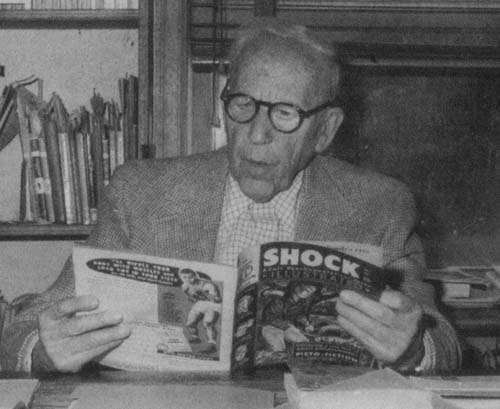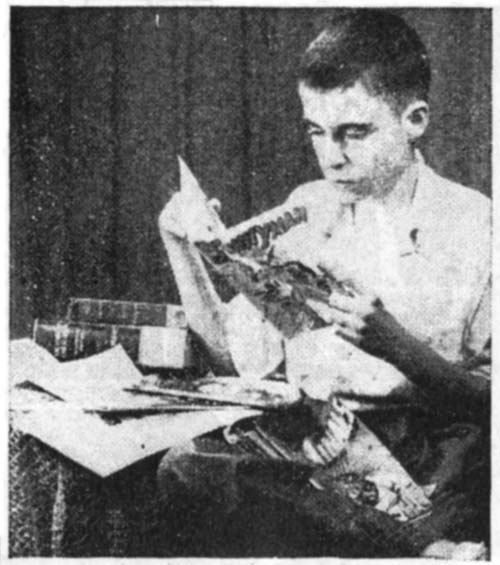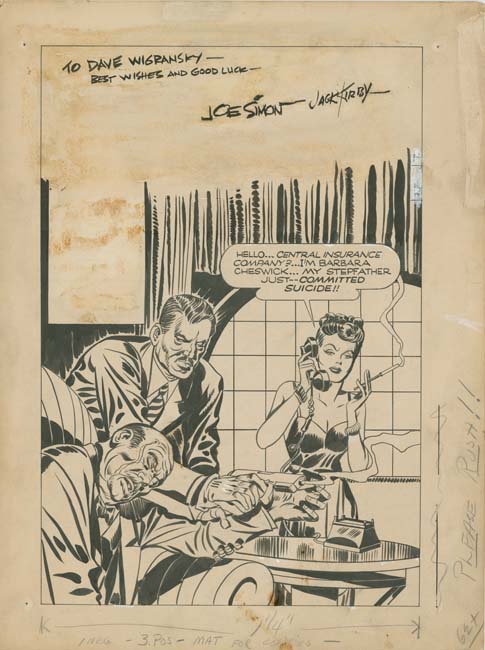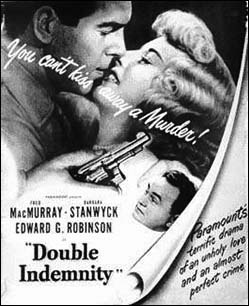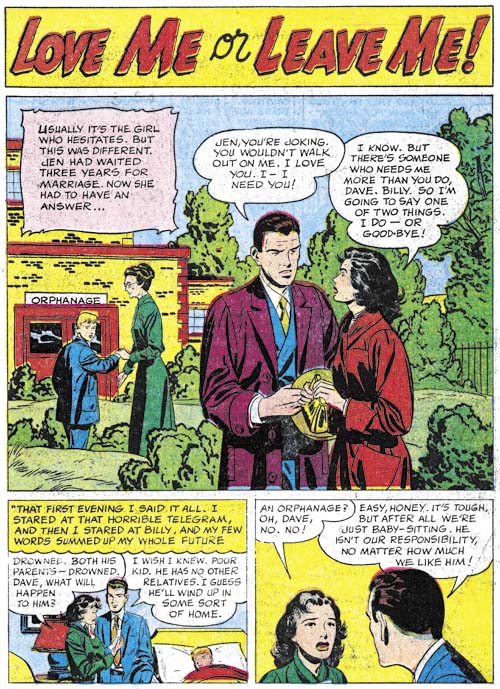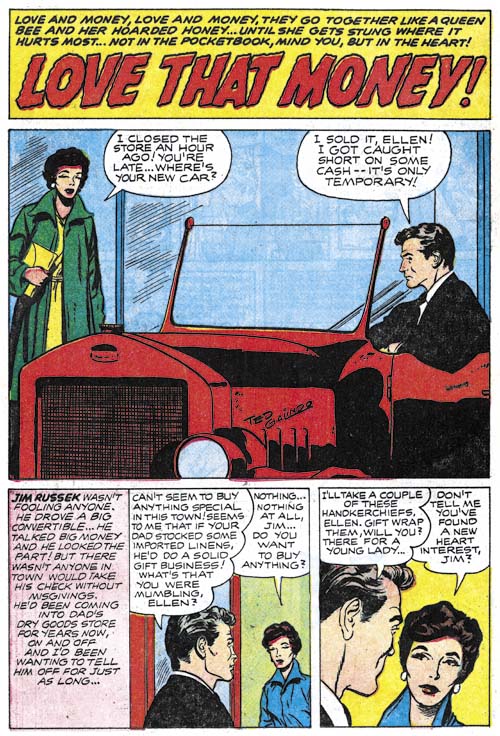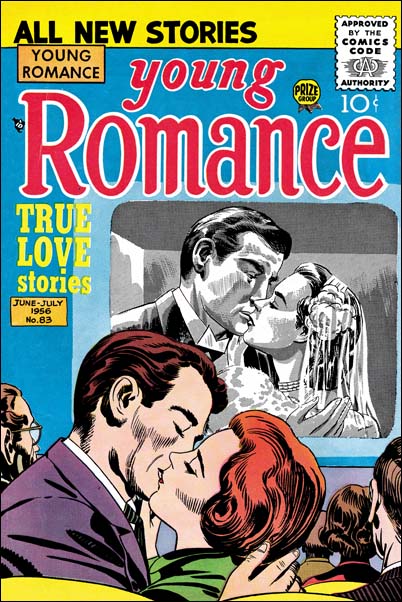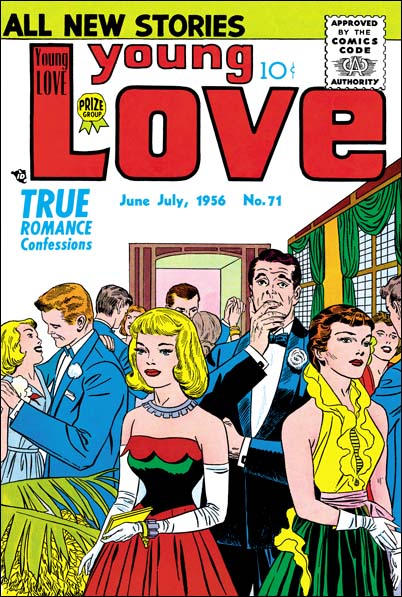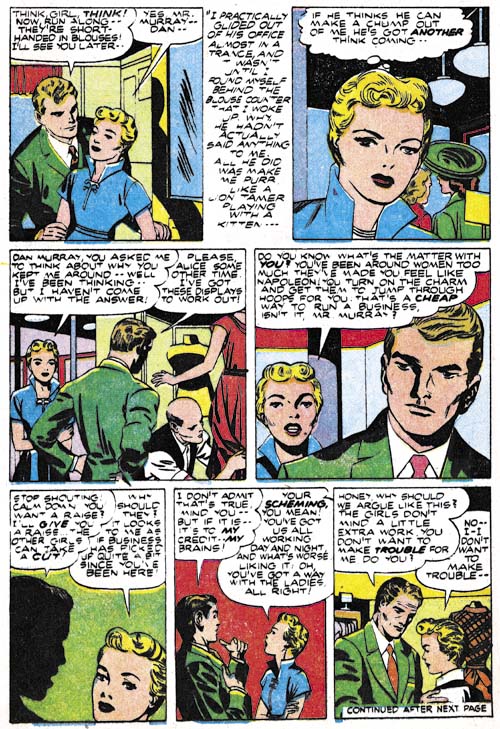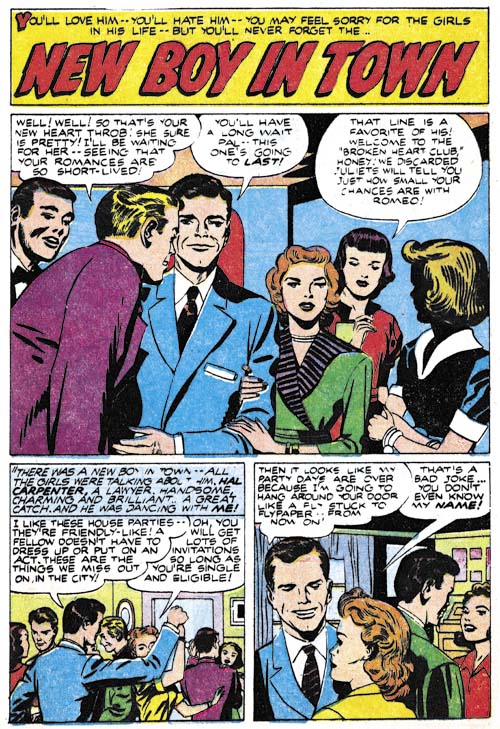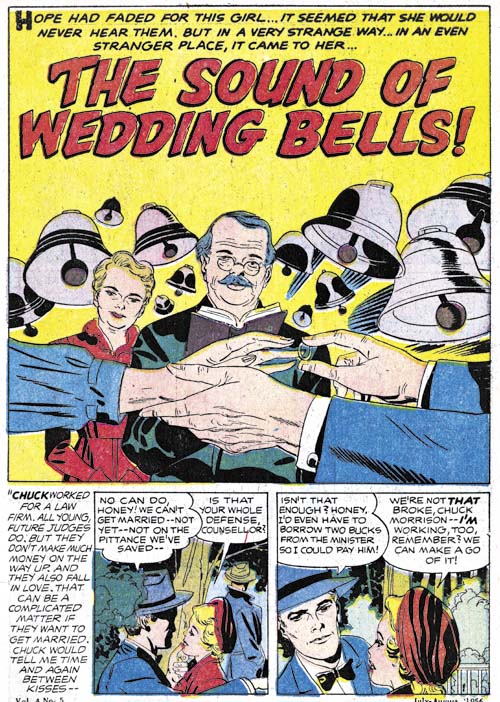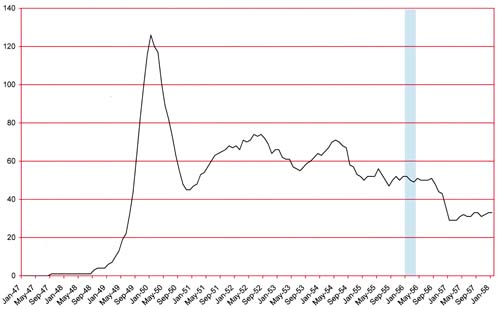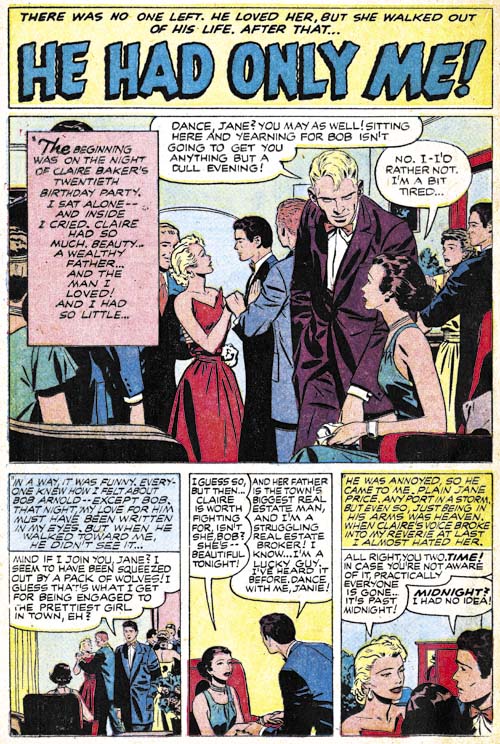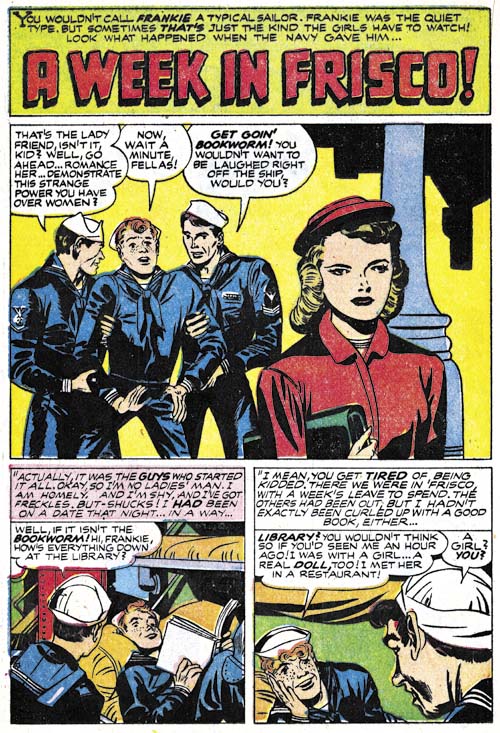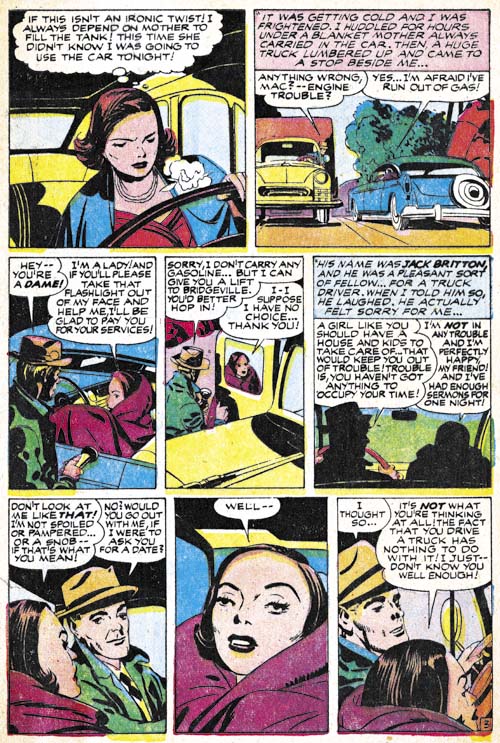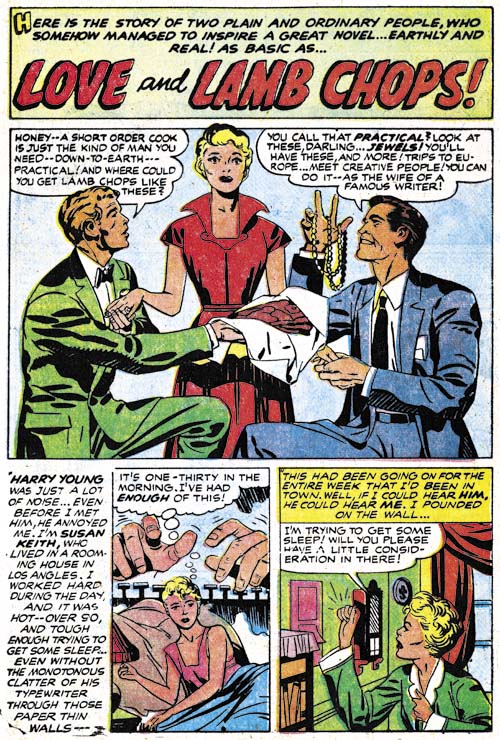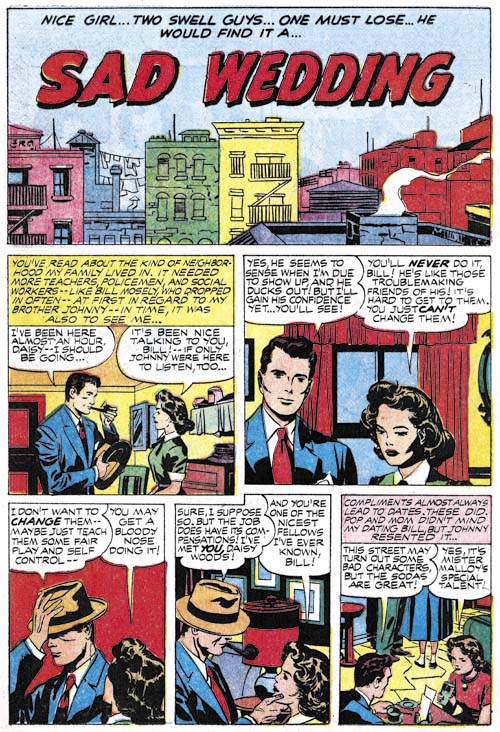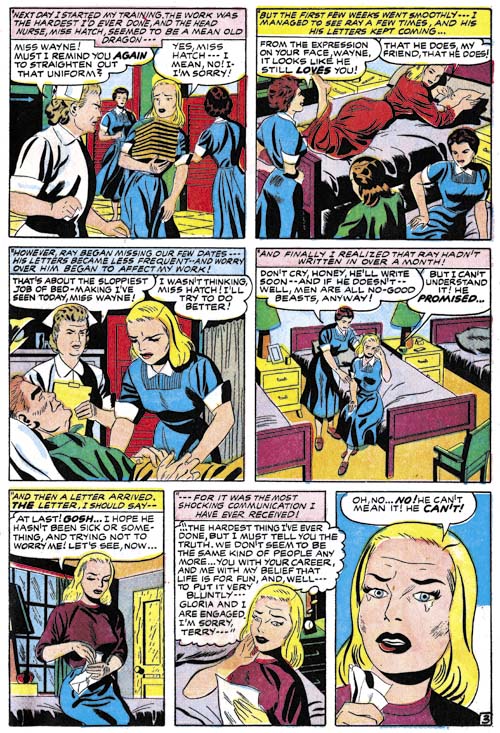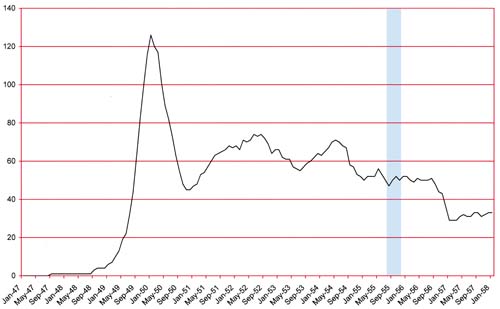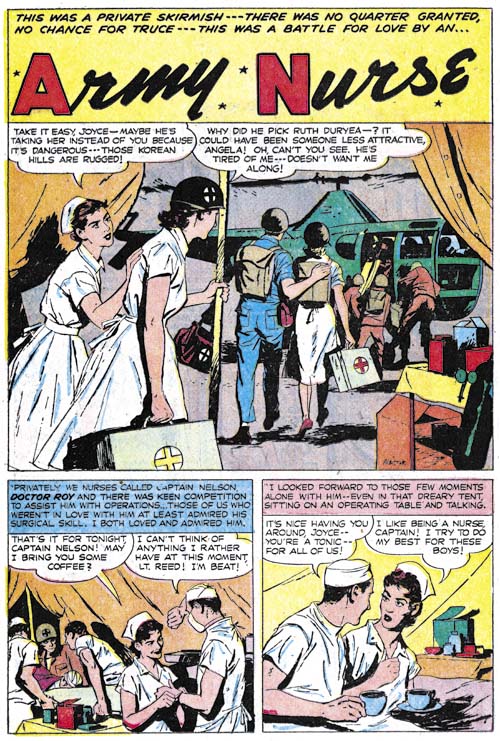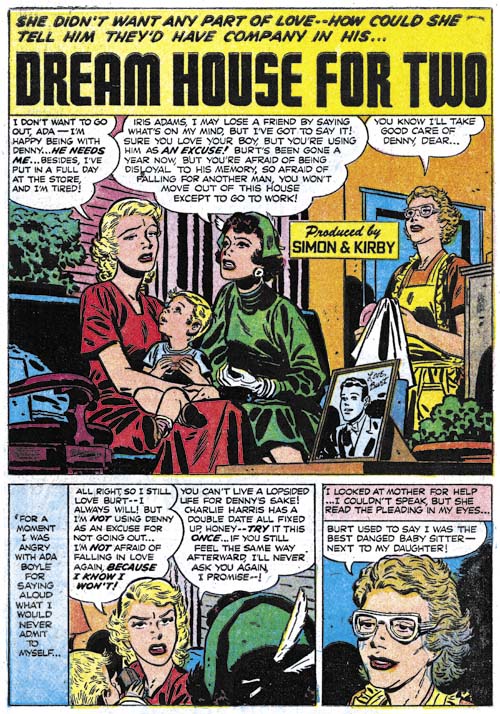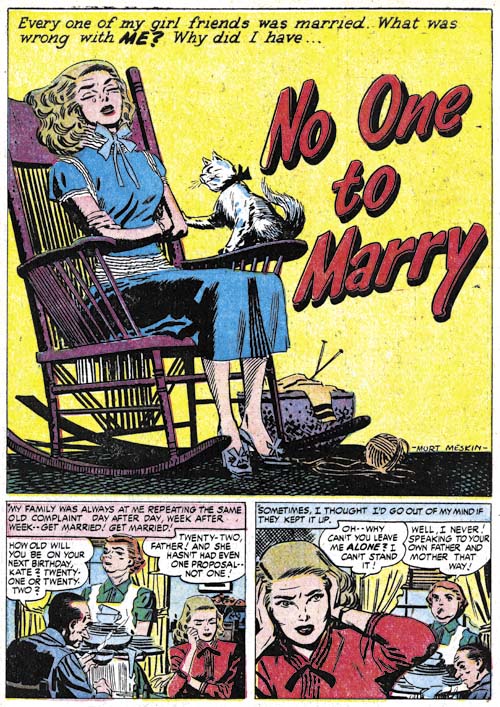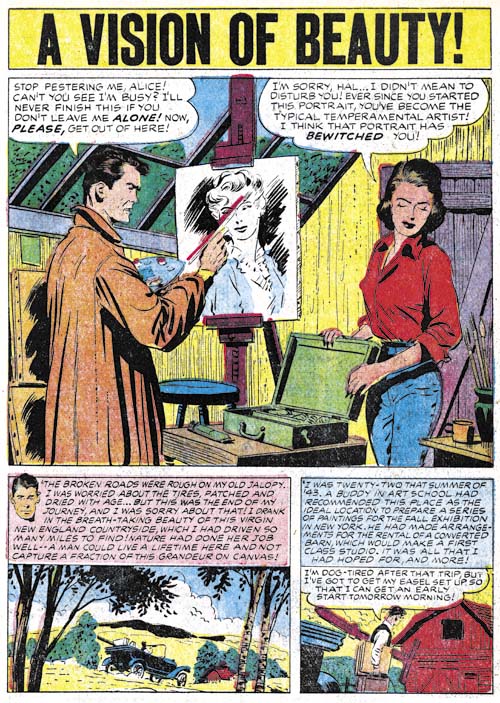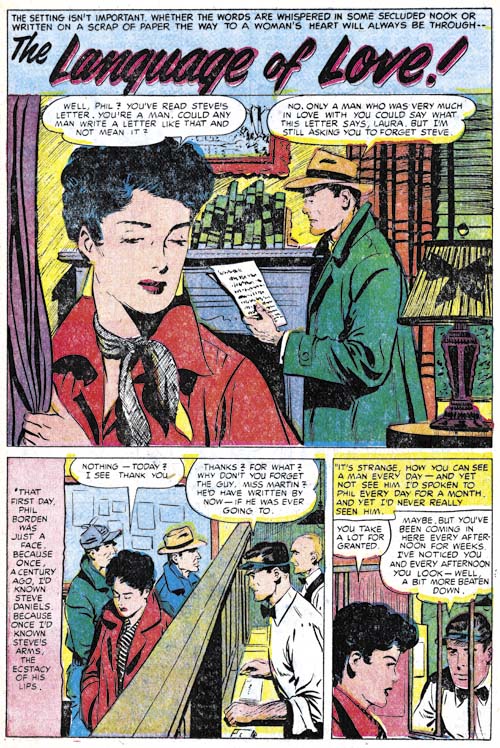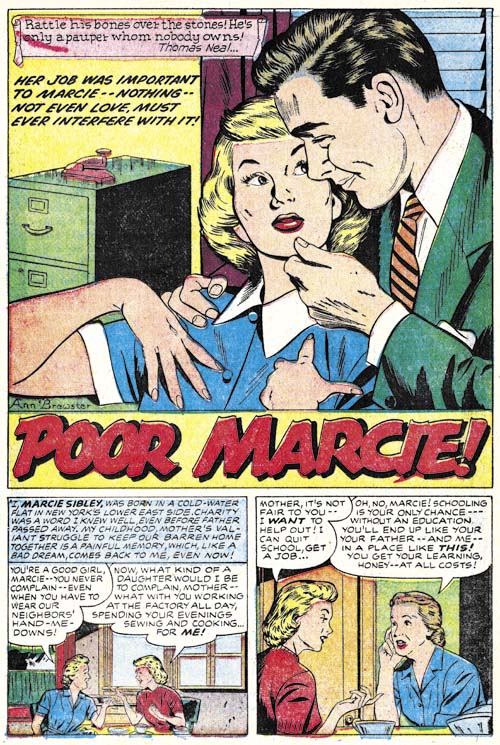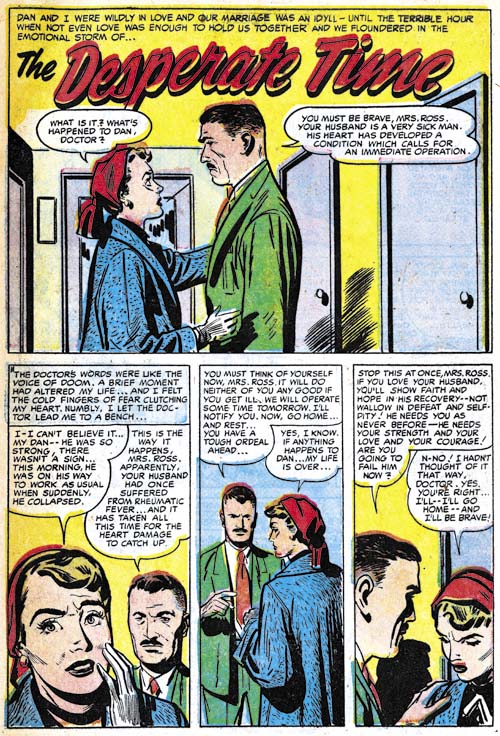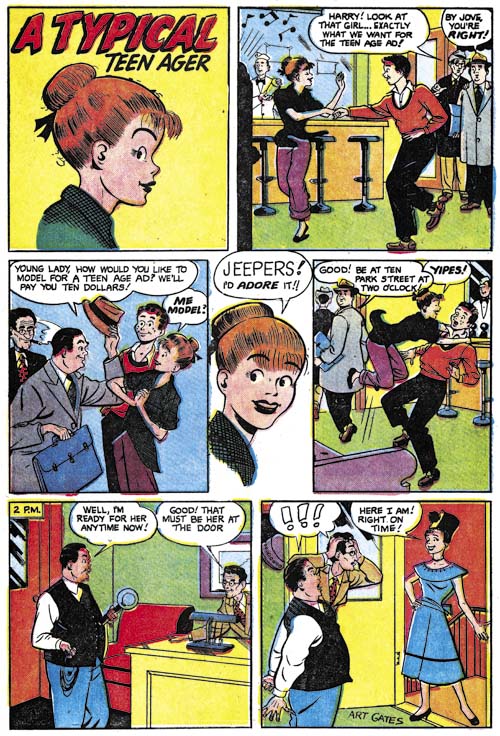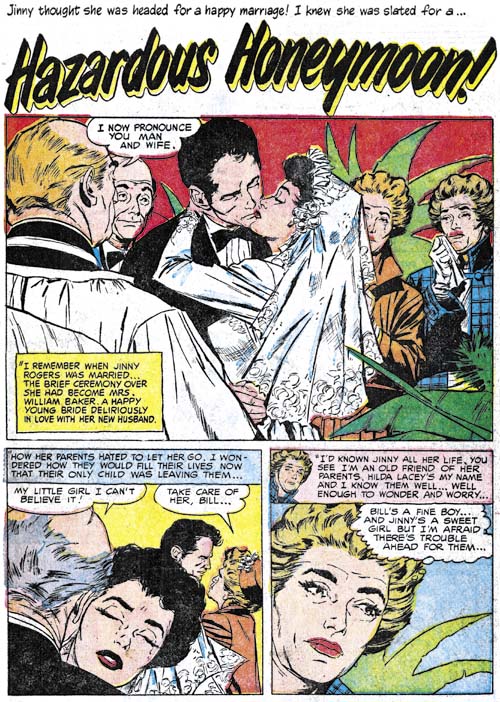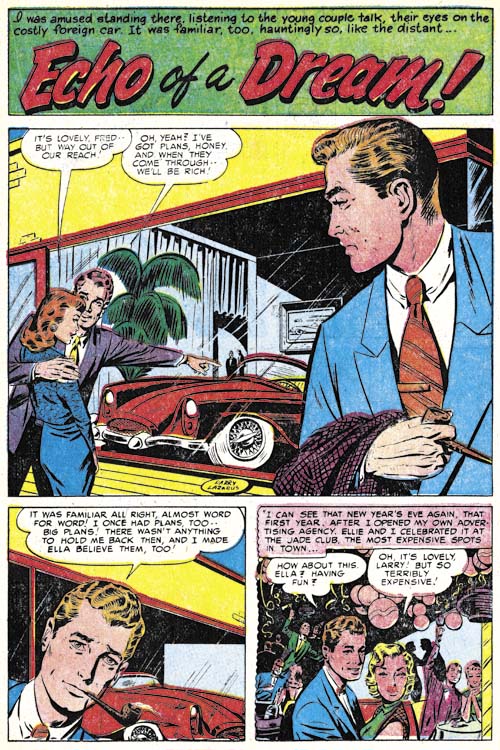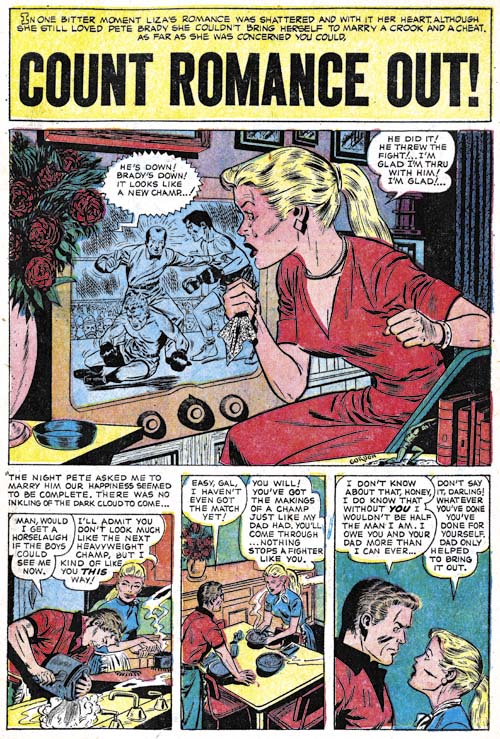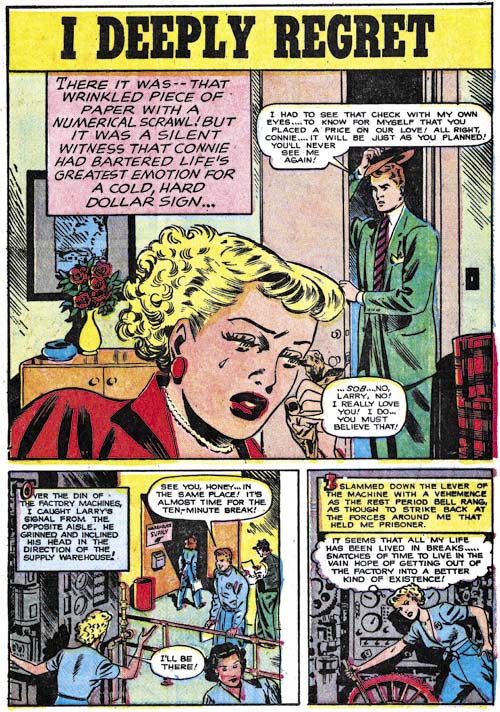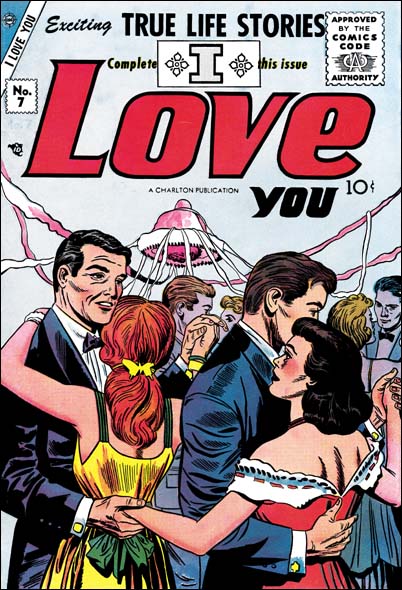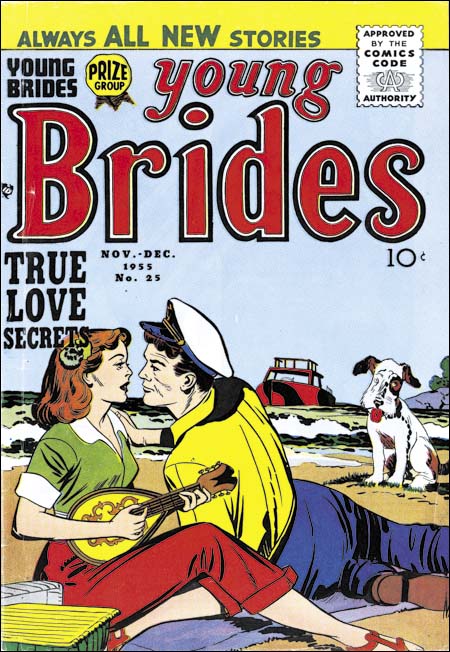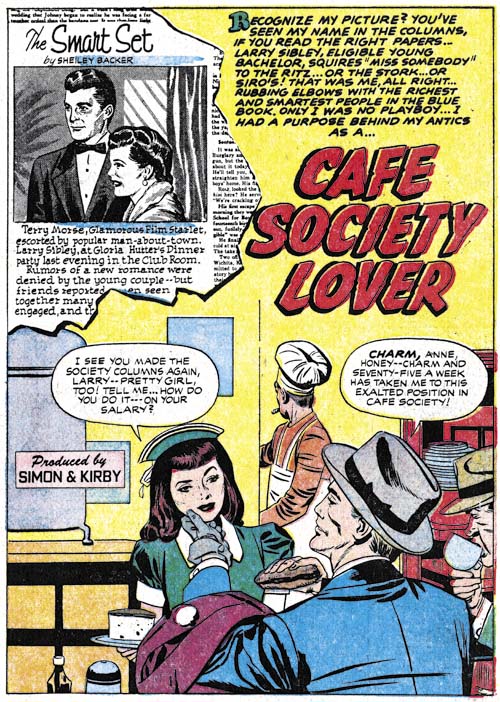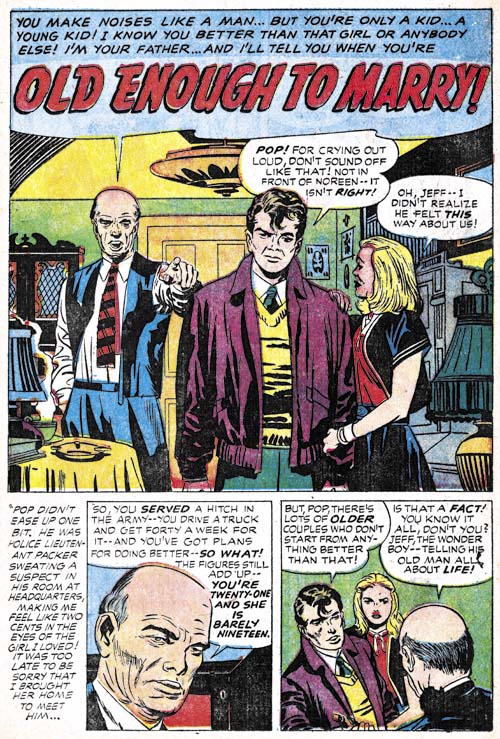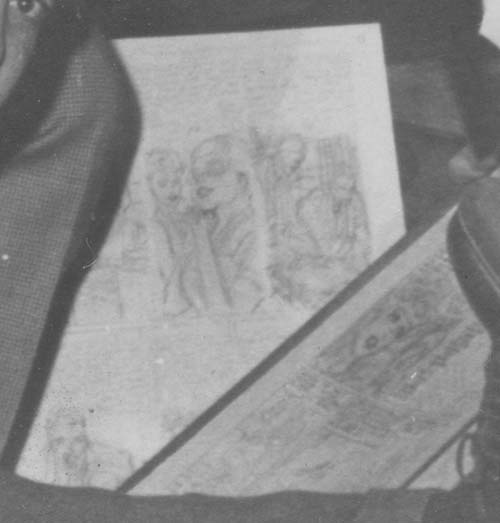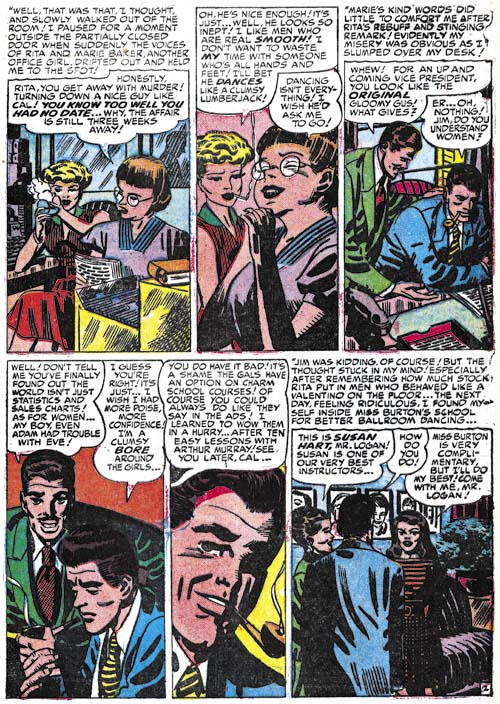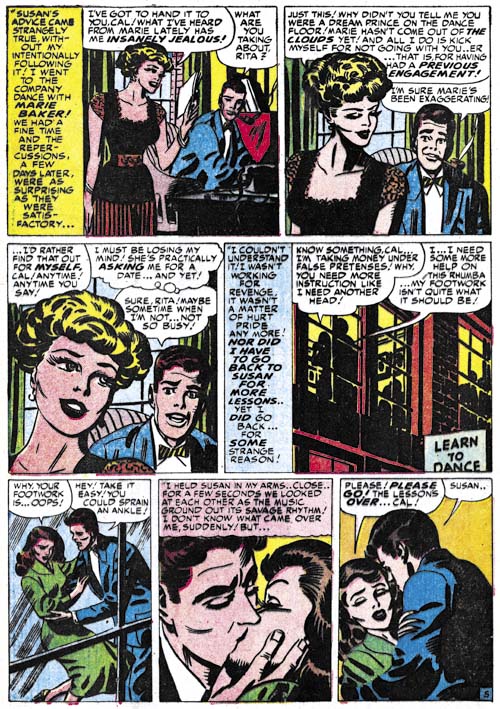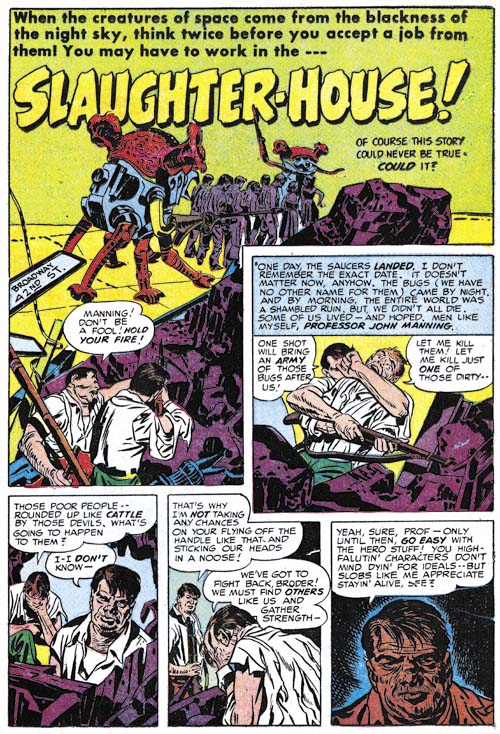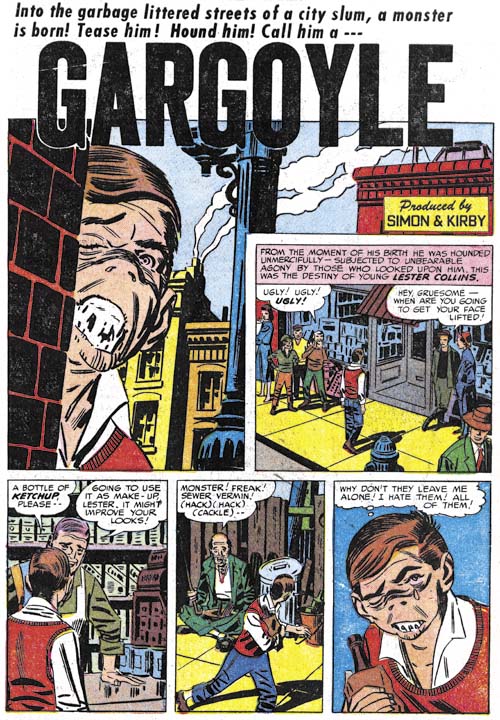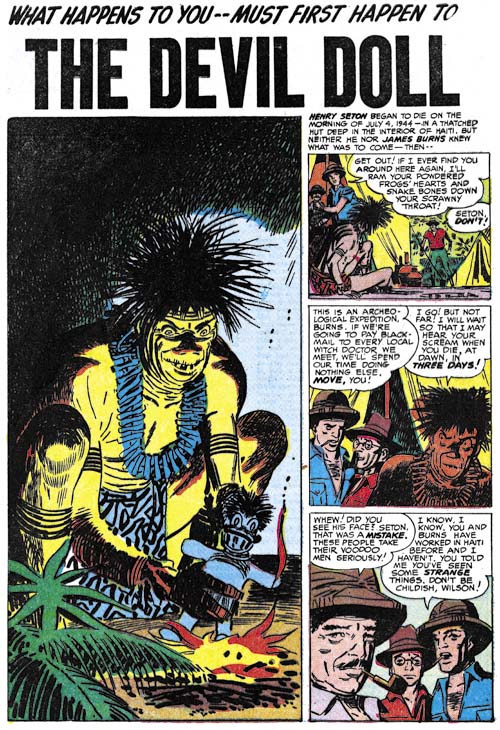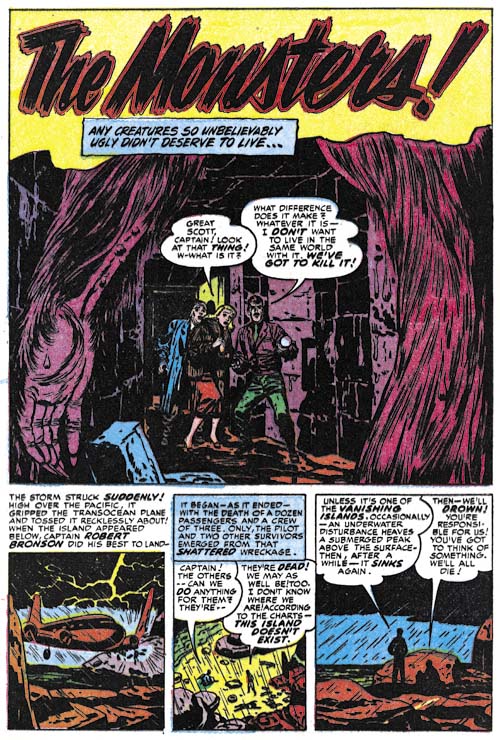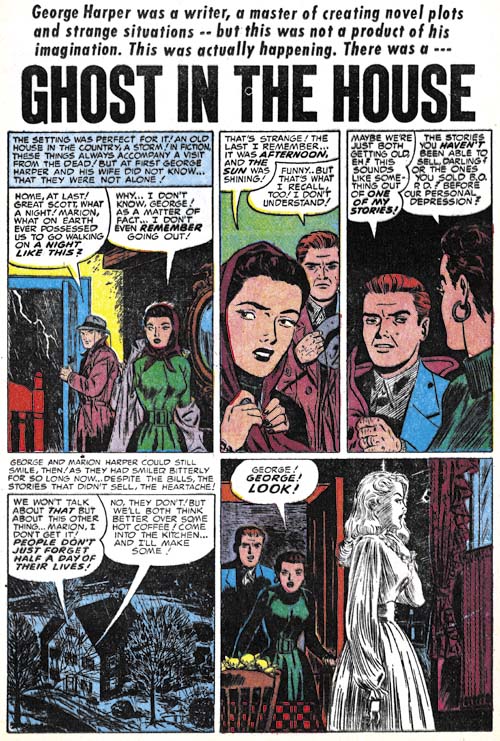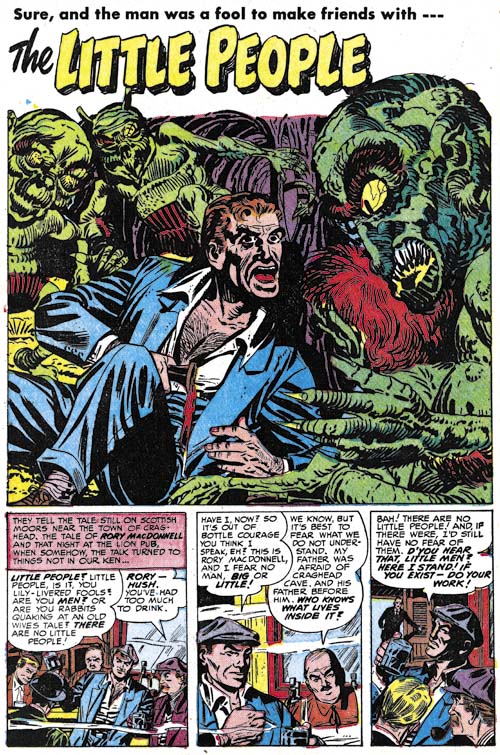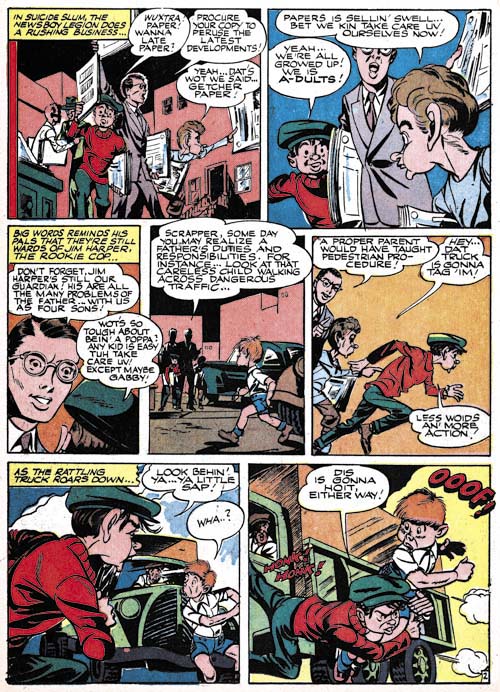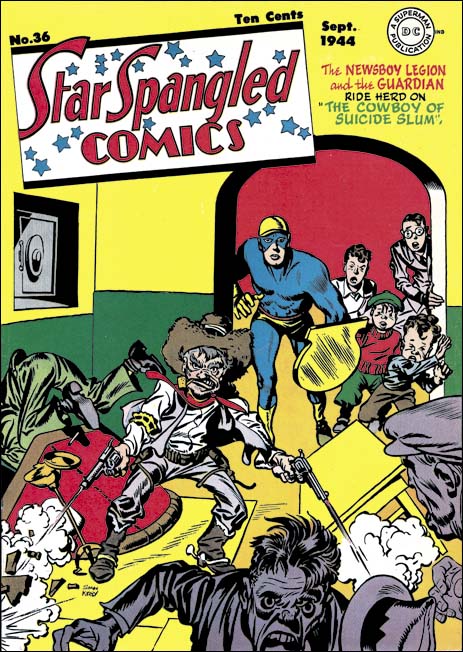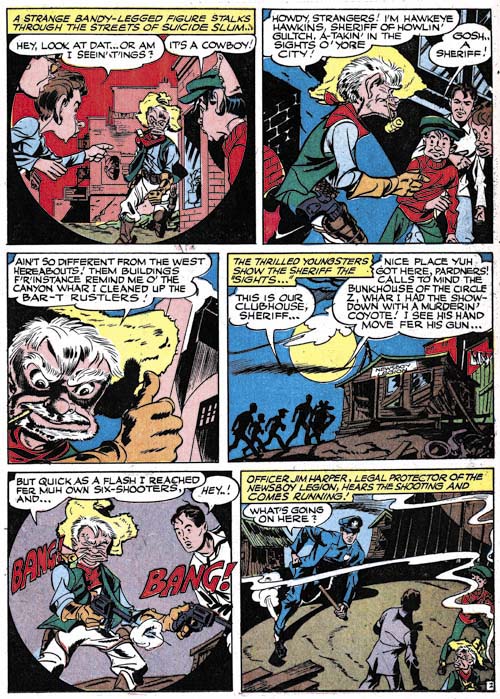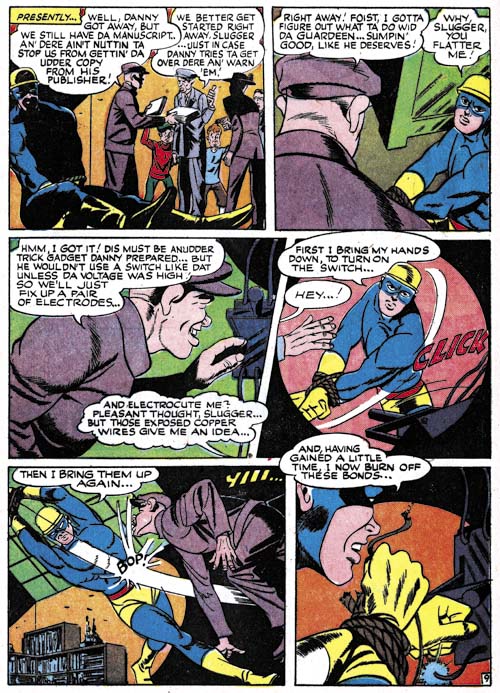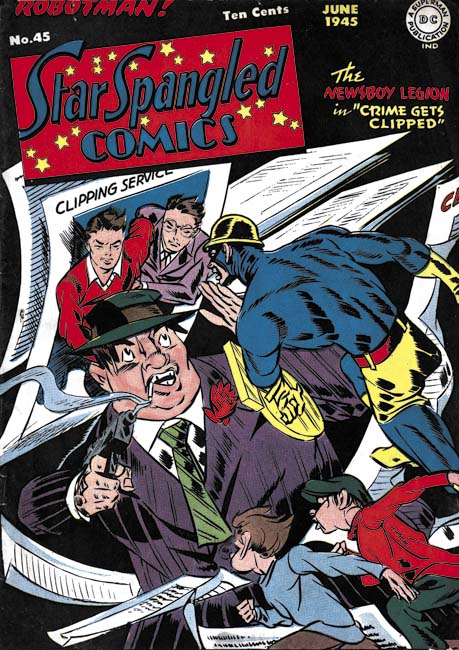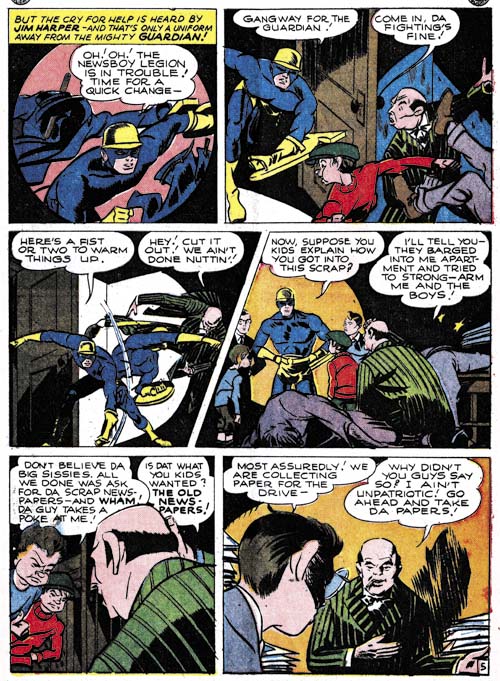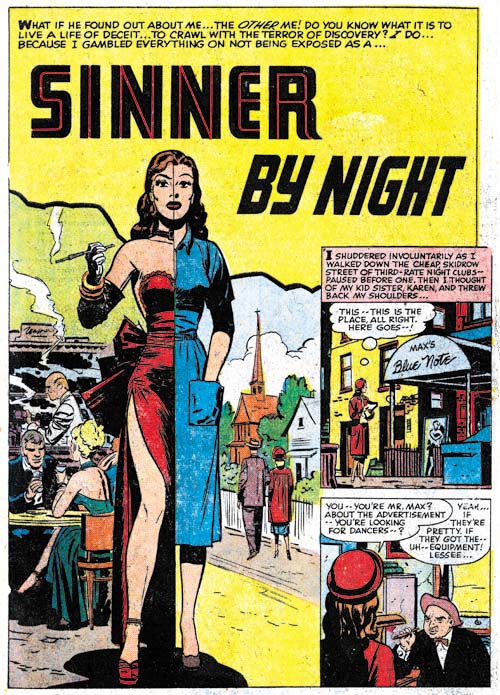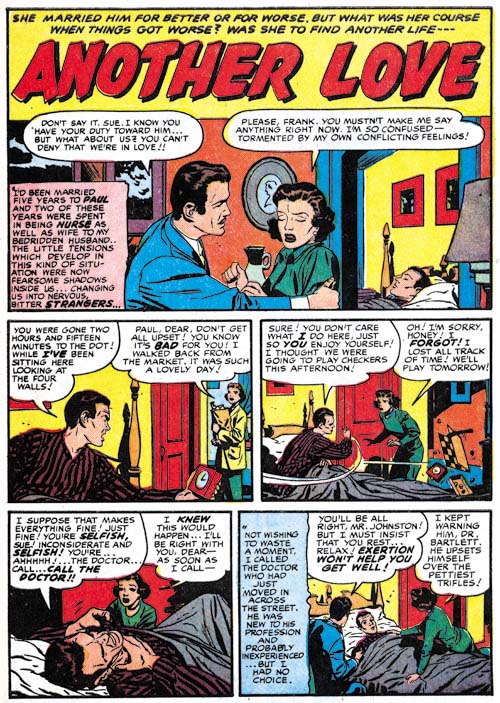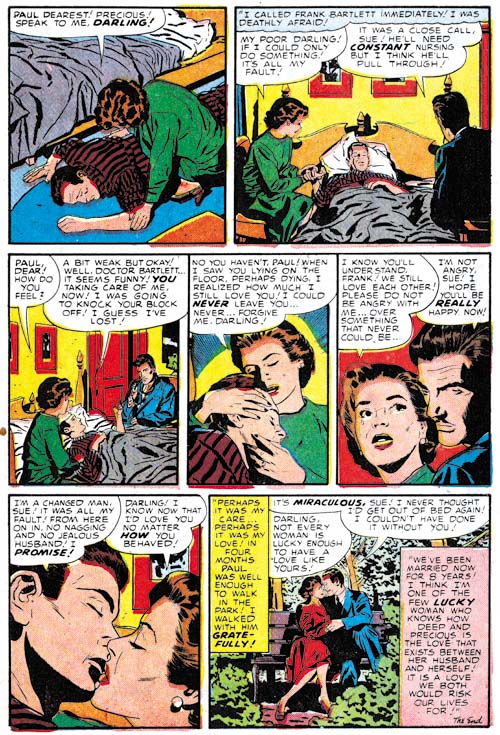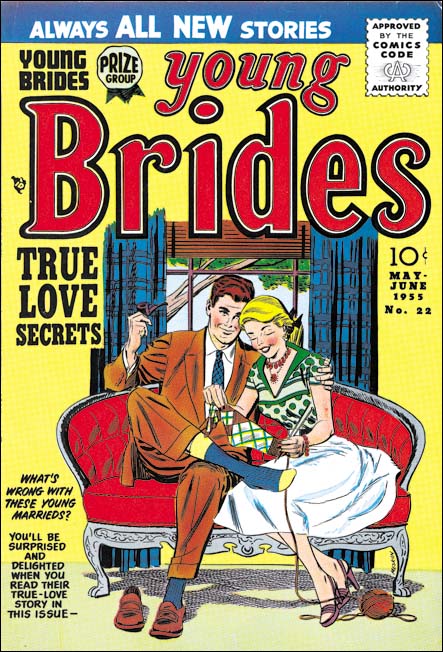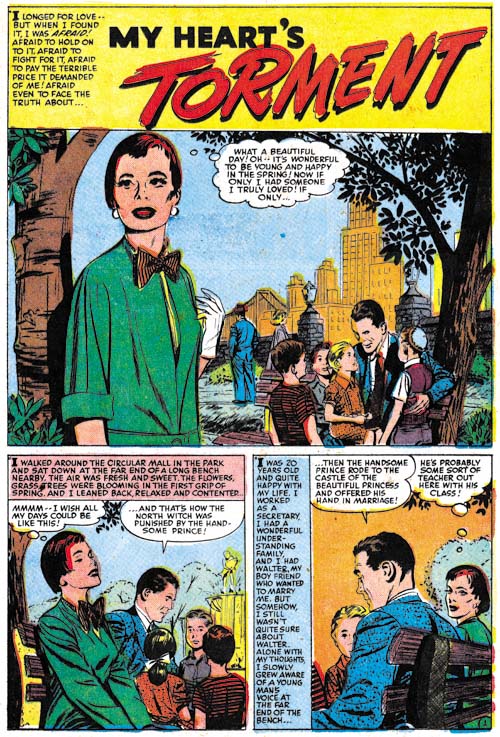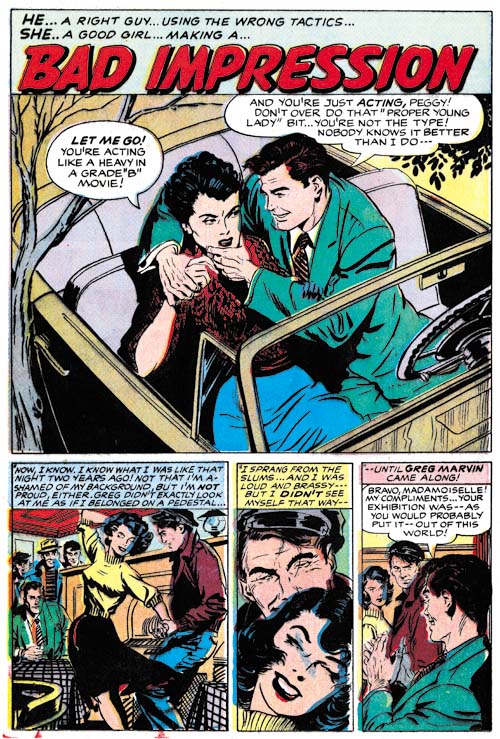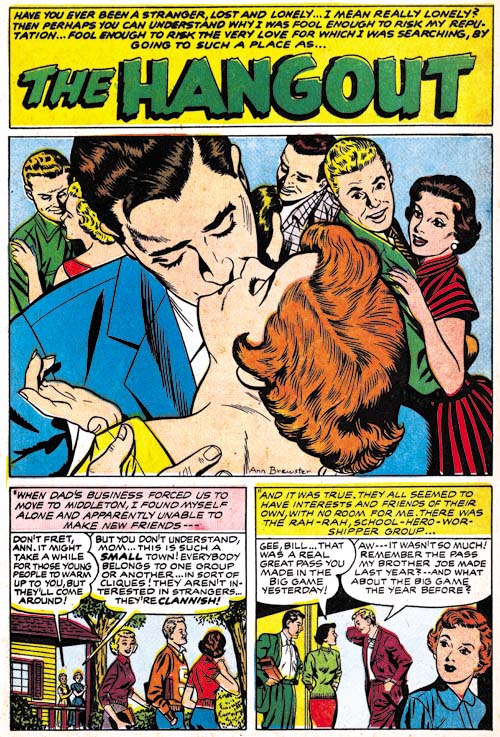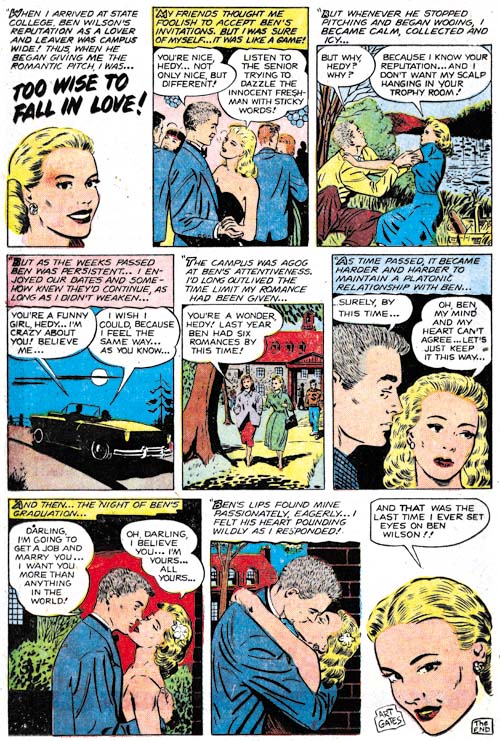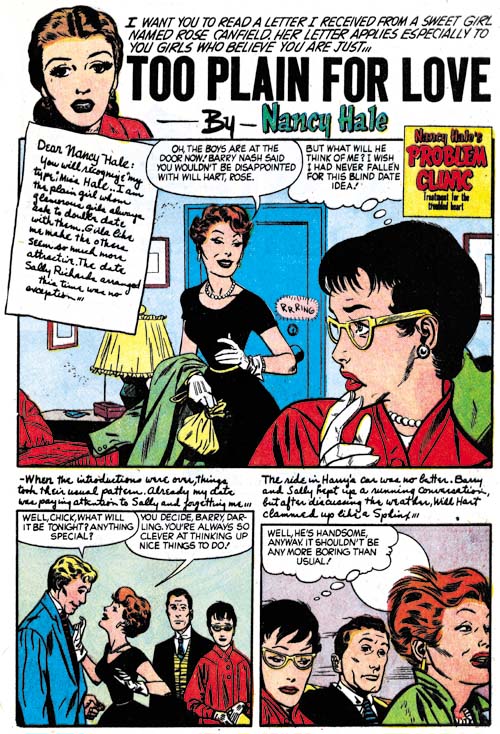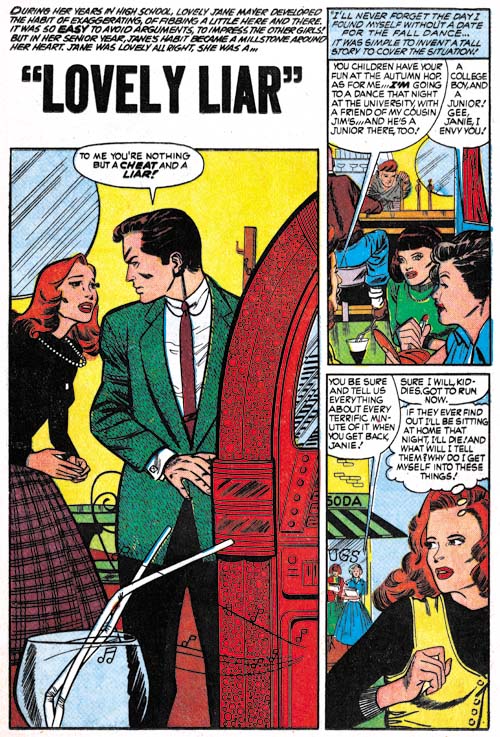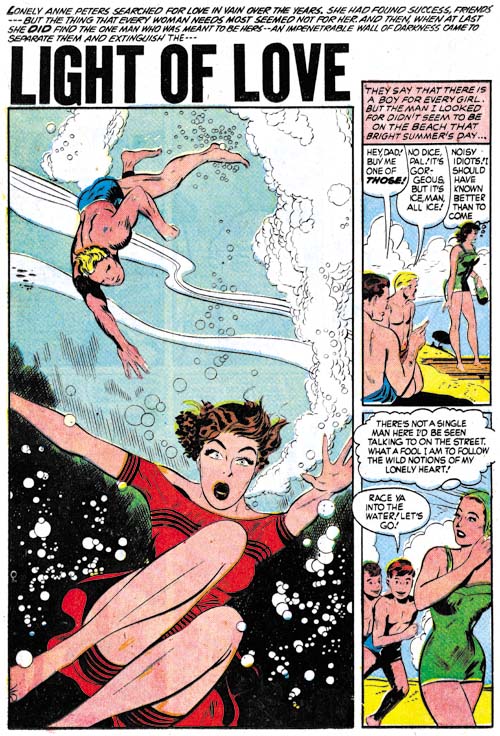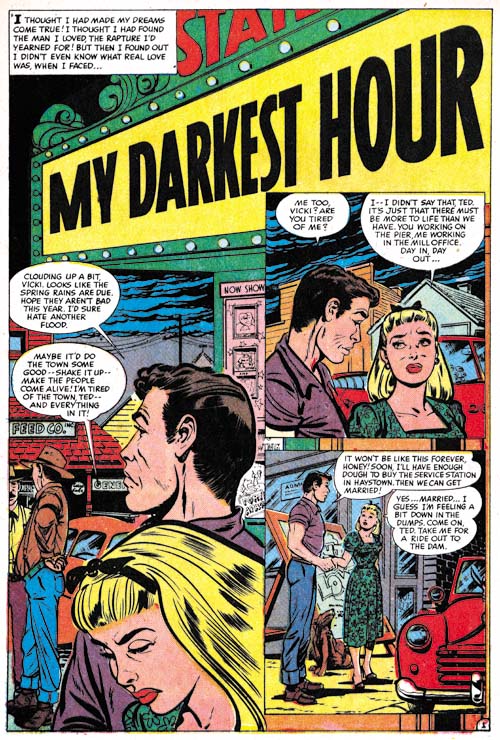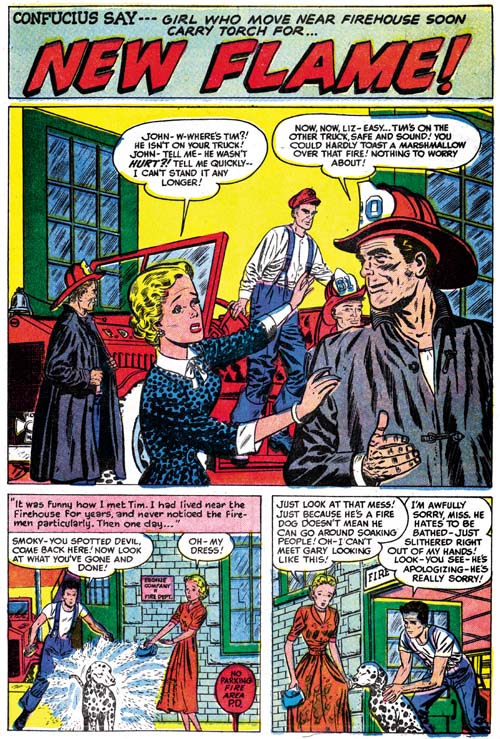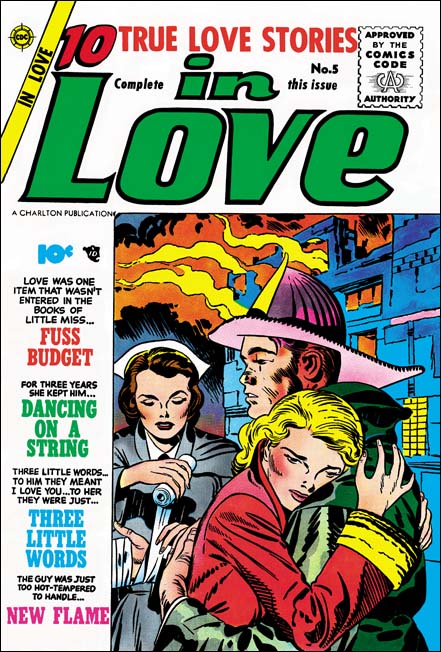(November 1956 – April 1957: Young Romance #85 – #87, Young Love #73, Young Brides #30, All For Love #1)
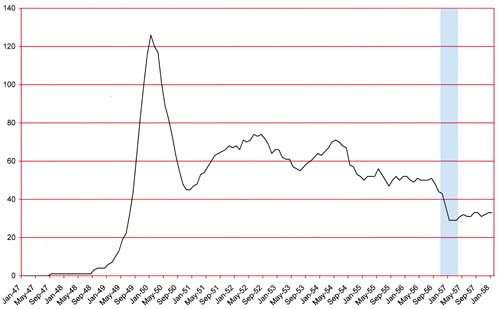
Number of Romance titles 1947 – 1958 (the period covered in this chapter is shaded in blue)
We now come to the end of the all Kirby Price romance comics and transition into a new and significantly different period of Prize Comics. Young Brides #30 (November 1956) and Young Romance #85 (December 1956) qualify as all-Kirby comics but only half of Young Love #73 (December 1956) was drawn by Kirby with the rest of the art done by Bill Draut. Unfortunately the comic book crash had finally caught up to Prize Comics. Young Love #73 and Young Brides #30 would be the final issues of those two titles although Young Love would be resurrected in 1960. At the point of cancellation Prize Comics would only be publishing three titles; Young Romance, Justice Traps the Guilty and Prize Comics Western. Since all were bi-monthlies this was a rather small line-up even for such a small company.
Starting with issue #86, Young Romance was a very changed title. The annual postal statements still listed Joe Simon and Jack Kirby as the editors but whatever working arrangement the two had it clearly was not the same as before. Kirby had started doing freelance work for DC and Atlas while Simon was doing some editorial work for Harvey Comics. Most, but not all, issues would include art drawn by Jack Kirby. Previously cover art was typically done by Kirby alone but now most covers would be done by other artists. The biggest change that came over the title was the largely complete absence of the earlier S&K Studio artists. Artists who previously played prominent rolls in the title such as Bill Draut, Mort Meskin, John Prentice and Bob McCarty would never again appear in Young Romance. The fact that some of these artists would show up in Prize romance titles not edited by Simon and Kirby suggests that there may have been some hard feelings between the artists and their former employers.
The change in Prize Comics was not a complete retreat but rather a reorganization. In April 1957 Prize came out with a new romance title, All For Love. It may seem strange to cancel two romance titles only to start up a new one. The answer is suggested by the Postal Statements which list Joe Genalo as the editor for All For Love. Prize not only wanted a new title, they particularly did not want Simon and Kirby to produce it.

Young Romance #85 (December 1956) “Lizzie’s Back In Town”, pencils by Jack Kirby
As I mentioned earlier, YR #85 was one of the issues that was drawn entirely by Jack Kirby. While the story art was often first rate, the splashes frequently left something to be desired. At least compared to the work Kirby had done in earlier years. The splash for “Lizzie’s Back In Town” is a good example of this. There is nothing wrong with the splash and granted it was probably a challenge to instill interest into some standing figures, but it was just this sort of romance splash that earlier Kirby was so good at. I suspect Kirby was just trying to do too much romance art in too little time. Some interesting splashes will be found in the future issues when Jack had returned to a more measured output of romance stories.
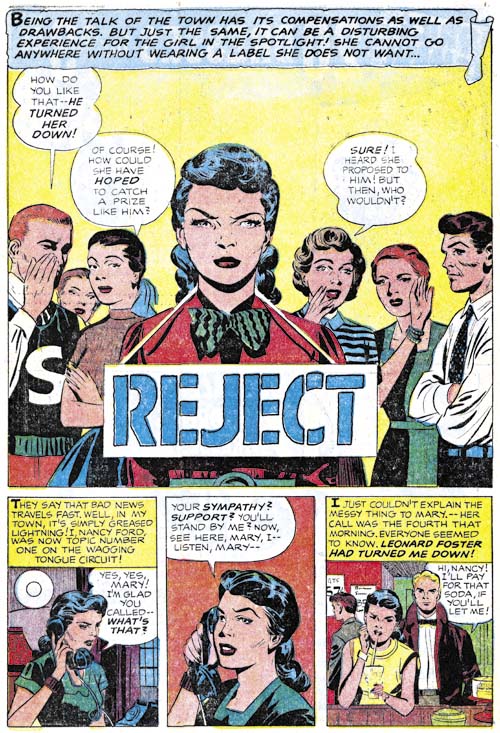
Young Romance #86 (February 1957) “Reject”, pencils by Jack Kirby
There are exceptions to lackluster splashes. I certainly like the one for “Reject”. This is not because of the subject matter because once again all there is are some standing figures. Nor is it the how well the art was handled; I suspect the original pencils were much better than what was left after the inker got finished with it. I think what appeals to me is the characterizations of the players; the stern central figure and the gossipers in the background. I also like the way the title of the story is placed on a placard worn by the lady.
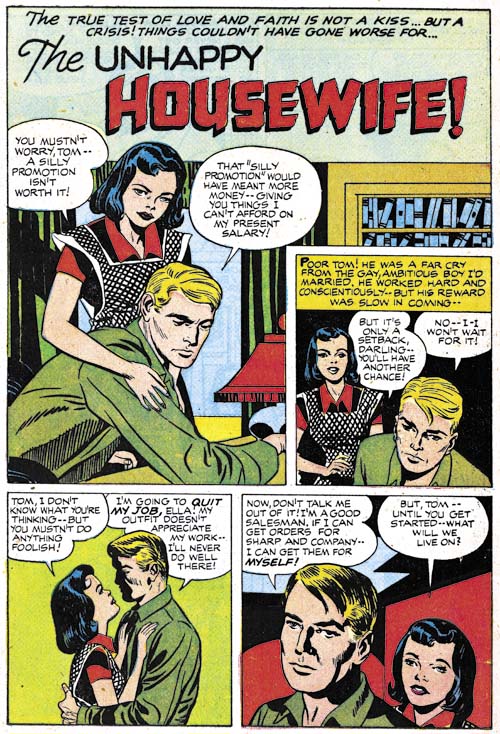
Young Brides #30 (November 1956) “The Unhappy Housewife”, pencils by Jack Kirby
There seems to have been one inker used for all the works penciled by Kirby during this period and a good portion of the art from the all-Kirby romance issues. In the past I had considered it likely that the inker was Marvin Stein. I have heard others advance Bill Draut and Joe Simon as candidates. During the review for this chapter I have come to the conclusion that I am just not sure who he was. In some places it looks like Bill Draut, other Marvin Stein or even Joe Simon. But I also feel it is quite possible that it was someone else entirely.
One interesting feature of the inking of the splash for “The Unhappy Housewife” is the presence of picket fence crosshatching (Inking Glossary). This technique was once a staple of the inking of Kirby pencils during much of the Simon and Kirby collaboration. Part of what I refer to as the Studio style inking. Picket fence crosshatching appears on some of the covers from this period but is largely absent in the stories.
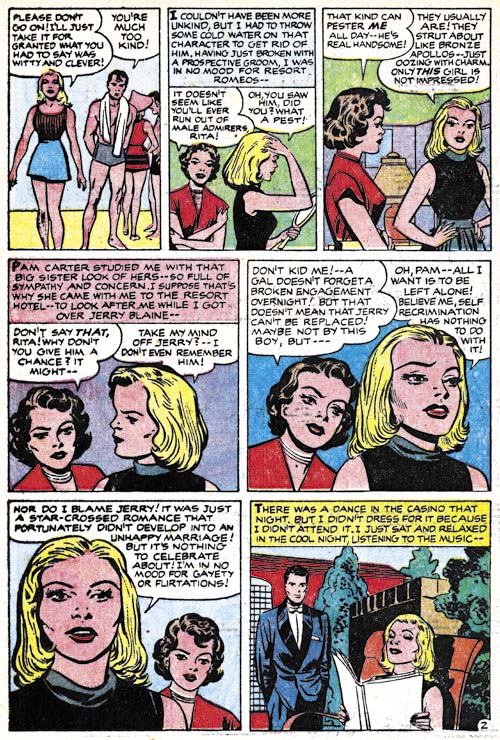
Young Romance #85 (December 1956) “Resort Romeo” page 2, pencils by Jack Kirby
The inking of eyebrows during this period were often done in a simplified but exaggerated manner. The women in panel 5 of the page shown above is a good example. There is some resemblance between these eyebrows and those used by Bill Draut which is the main reason to suggest Draut was the inker for these Kirby pencils. Unfortunately I cannot find any other evidence to support crediting Draut as Kirby’s inker during this period. But I will return to this subject below.
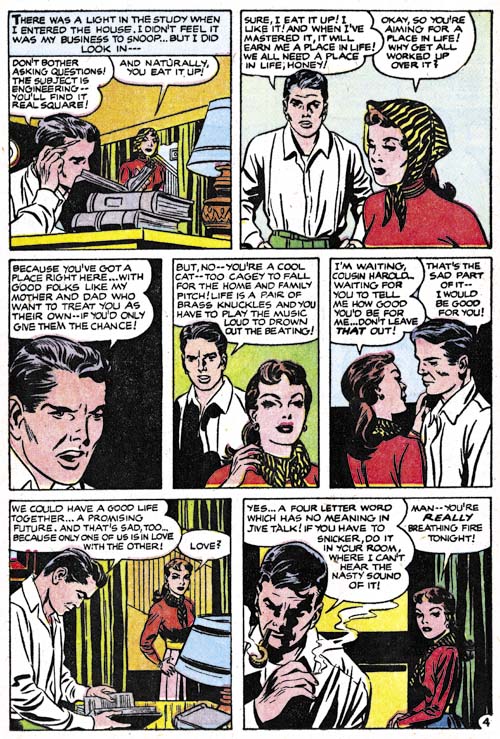
Young Romance #87 (April 1957) “Rock n’ Roll Sweetheart” page 4, pencils by Jack Kirby
Note the inking of the man’s face in the last panel from page 4 of “Rock n’ Roll Sweetheart”. The black shadow down one side of the face is what I refer to as negative highlights. I have never seen Bill Draut use negative highlights but Marvin Stein did and his looked very much like this example. Because the inking evidence does not consistantly suggest one inker, I have decided to no longer attribute the inking to Marvin Stein and for now leave it as an open question.
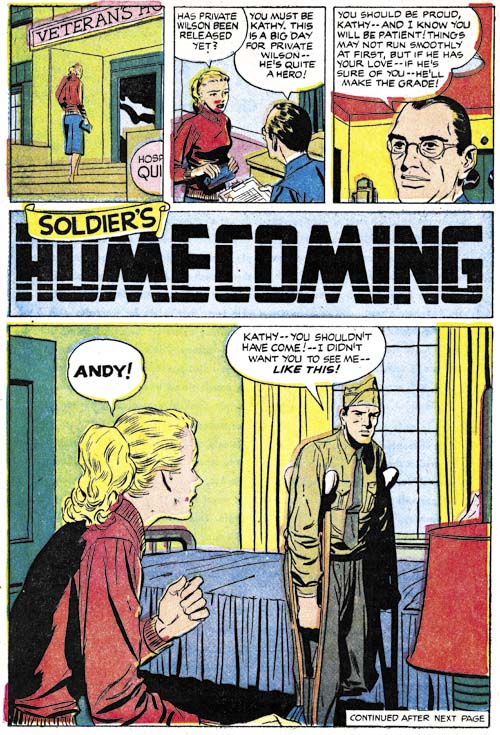
Young Love #73 (December 1956) “Soldier’s Homecoming”, pencils and inks by Bill Draut
Bill Draut provided two of the four stories from the final issue of Young Love. The style is similar to that he was using just prior to the start of the all-Kirby run. However even that was somewhat different from his earlier work. This is most notably seen in the clothing folds which earlier had been somewhat splotchy but now where cleaner and more streamlined.
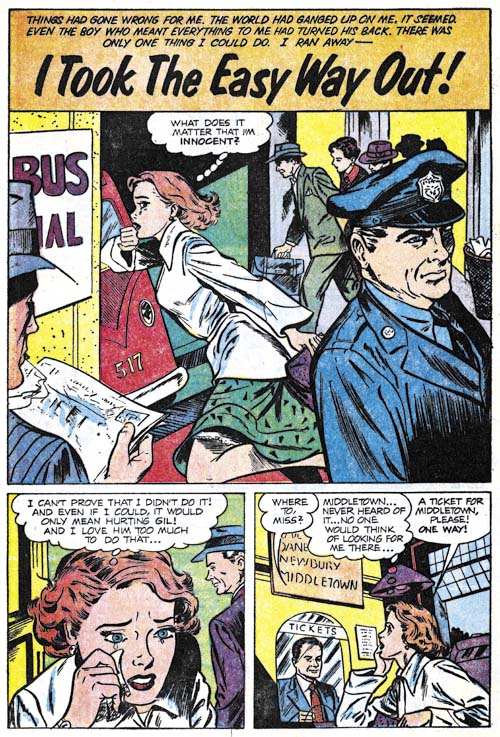
Young Romance #86 (February 1957) “I Took The Easy Way Out”, art by unidentified artist
The first issue (YR #87) of Young Romance after the cancellation of Young Love and Young Brides had only a single Kirby story. Oddly the other three stories were all done by the same artist. He is not a bad artist, but I do not believe I have seen him in a Simon and Kirby production before. It is a puzzle why he suddenly achieved such dominance in this romance title.
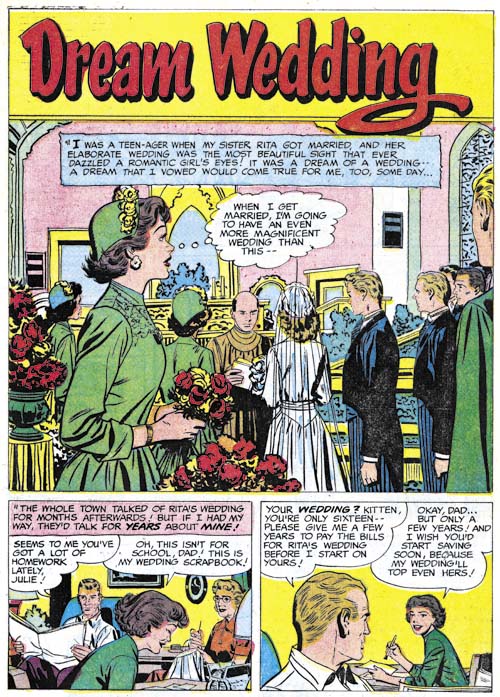
All For Love #1 (April 1957) “Dream Wedding”, art by Bill Draut
As mentioned above, the new Prize romance title All For Love, was not produced by Simon and Kirby. One of the things I will be looking for in future chapters of the Art of Romance was whether the same artists would appear in Young Romance and the Prize titles that were not produced by Simon and Kirby. One artist that shows up in the first issue is Bill Draut. Not only does Draut provide a story but he did the cover art as well. Here Bill is working in the same style we saw Young Romance #86 (February 1957).
Bill had also been appearing in some of the Harvey romance titles at this time which I believe were edited by Joe Simon. But it is unclear whether these were new stories or reprints of older material. In any case work by Draut for Harvey would end at this same time. Draut would not work with Joe Simon on comics until 1966. Bill did work on Sick but right now I am not sure when that was.
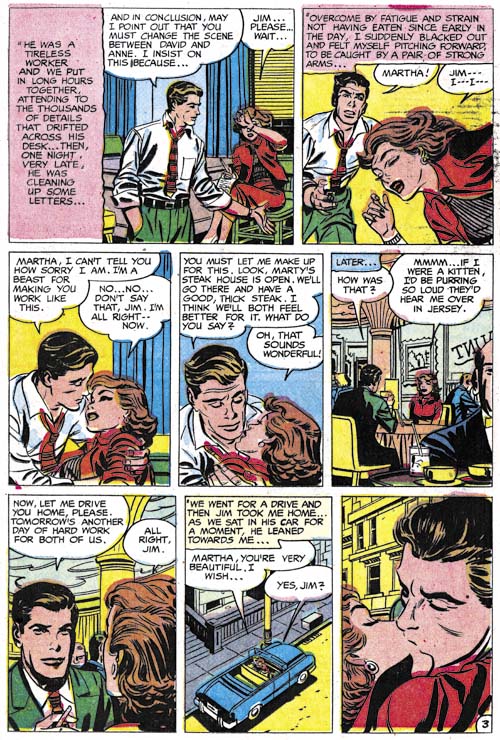
All For Love #1 (April 1957) “Hollow Triumph” page 3, art by Mort Meskin?
There are two stories in All For Love #1 that I am somewhat uncertain about. I some ways “Hollow Triumph” reminds me of the work of Mort Meskin. The way the eyebrows are inked might suggest Bill Draut but the story lacks any of Draut’s mannerisms of graphically telling the story, in particular the body language depicted and how the use of view points. Meskin is a better fit in just these graphic qualities. However if this was drawn by Mort I am certain it was not inked by him. Some of the inking reminds me of the unidentified inker for Kirby that I discussed above.
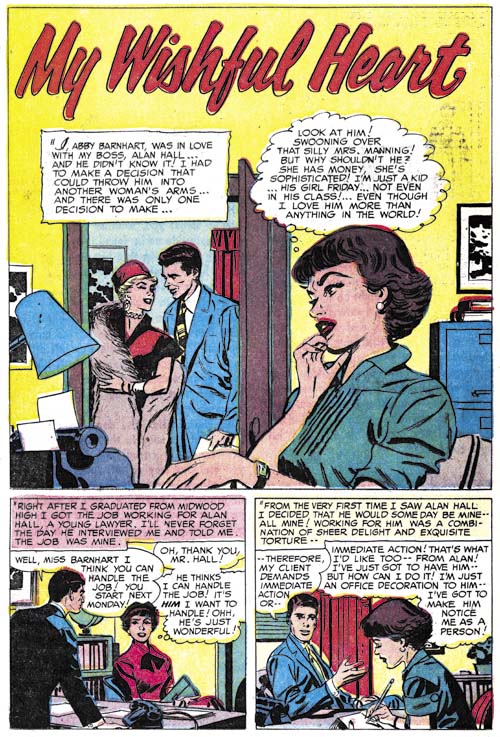
All For Love #1 (April 1957) “My Wishful Heart”, art by Bill Draut?
“My Wishful Heart” is the other story that I questionably attribute to Mort Meskin. Although not identical to “Hollow Triumph” it is close enough to suggest it was done by the same artist.

All For Love #1 (April 1957) “I Was Only Cheating Myself”, art by Ted Galindo
The only other romance artist from this period that I can identify other than Jack Kirby, Bill Draut and possibly Mort Meskin was Ted Galindo. Ted does a real nice job on his romance stories. His women are attractive and his art style more modern than most of the artists that I have discussed so far. Galindo’s use of changing viewpoints keeps his stories graphically interesting. we will be seeing more of his work
We are now coming into the final period covered by the Art of Romance. It was always my intention to take this serial post up to 1960. However I am really uncertain how many chapters remain. Frankly overall I find the Prize romance titles from this point on the least interesting of the series. If not for the presence of Jack Kirby I might be tempted to cover it in some future serial post. But there is some really great Kirby art, much of it inked by Jack himself. Plus some other interesting artists appeared from time to time.
Chapter 1, A New Genre (YR #1 – #4)
Chapter 2, Early Artists (YR #1 – #4)
Chapter 3, The Field No Longer Their’s Alone (YR #5 – #8)
Chapter 4, An Explosion of Romance (YR #9 – #12, YL #1 – #4)
Chapter 5, New Talent (YR #9 – 12, YL #1 – #4)
Chapter 6, Love on the Range (RWR #1 – #7, WL #1 – #6)
Chapter 7, More Love on the Range (RWR #1 – #7, WL #1 – #6)
Chapter 8, Kirby on the Range? (RWR #1 – #7, WL #1 – #6)
Chapter 9, More Romance (YR #13 – #16, YL #5 – #6)
Chapter 10, The Peak of the Love Glut (YR #17 – #20, YL #7 – #8)
Chapter 11, After the Glut (YR #21 – #23, YL #9 – #10)
Chapter 12, A Smaller Studio (YR #24 – #26, YL #12 – #14)
Chapter 13, Romance Bottoms Out (YR #27 – #29, YL #15 – #17)
Chapter 14, The Third Suspect (YR #30 – #32, YL #18 – #20)
Chapter 15, The Action of Romance (YR #33 – #35, YL #21 – #23)
Chapter 16, Someone Old and Someone New (YR #36 – #38, YL #24 – #26)
Chapter 17, The Assistant (YR #39 – #41, YL #27 – #29)
Chapter 18, Meskin Takes Over (YR #42 – #44, YL #30 – #32)
Chapter 19, More Artists (YR #45 – #47, YL #33 – #35)
Chapter 20, Romance Still Matters (YR #48 – #50, YL #36 – #38, YB #1)
Chapter 21, Roussos Messes Up (YR #51 – #53, YL #39 – #41, YB #2 – 3)
Chapter 22, He’s the Man (YR #54 – #56, YL #42 – #44, YB #4)
Chapter 23, New Ways of Doing Things (YR #57 – #59, YL #45 – #47, YB #5 – #6)
Chapter 24, A New Artist (YR #60 – #62, YL #48 – #50, YB #7 – #8)
Chapter 25, More New Faces (YR #63 – #65, YLe #51 – #53, YB #9 – #11)
Chapter 26, Goodbye Jack (YR #66 – #68, YL #54 – #56, YB #12 – #14)
Chapter 27, The Return of Mort (YR #69 – #71, YL #57 – #59, YB #15 – #17)
Chapter 28, A Glut of Artists (YR #72 – #74, YL #60 – #62, YB #18 & #19, IL #1 & #2)
Chapter 29, Trouble Begins (YR #75 – #77, YL #63 – #65, YB #20 – #22, IL #3 – #5)
Chapter 30, Transition (YR #78 – #80, YL #66 – #68, YBs #23 – #25, IL #6, ILY #7)
Chapter 30, Appendix (YB #23)
Chapter 31, Kirby, Kirby and More Kirby (YR #81 – #82, YL #69 – #70, YB #26 – #27)
Chapter 32, The Kirby Beat Goes On (YR #83 – #84, YL #71 – #72, YB #28 – #29)
Chapter 33, End of an Era (YR #85 – #87, YL #73, YB #30, AFL #1)
Chapter 34, A New Prize Title (YR #88 – #91, AFL #2 – #5, PL #1 – #2)
Chapter 35, Settling In ( YR #92 – #94, AFL #6 – #8, PL #3 – #5)
Appendix, J.O. Is Joe Orlando
Chapter 36, More Kirby (YR #95 – #97, AFL #9 – #11, PL #6 – #8)
Chapter 37, Some Surprises (YR #98 – #100, AFL #12 – #14, PL #9 – #11)
Chapter 38, All Things Must End (YR #101 – #103, AFL #15 – #17, PL #12 – #14)


